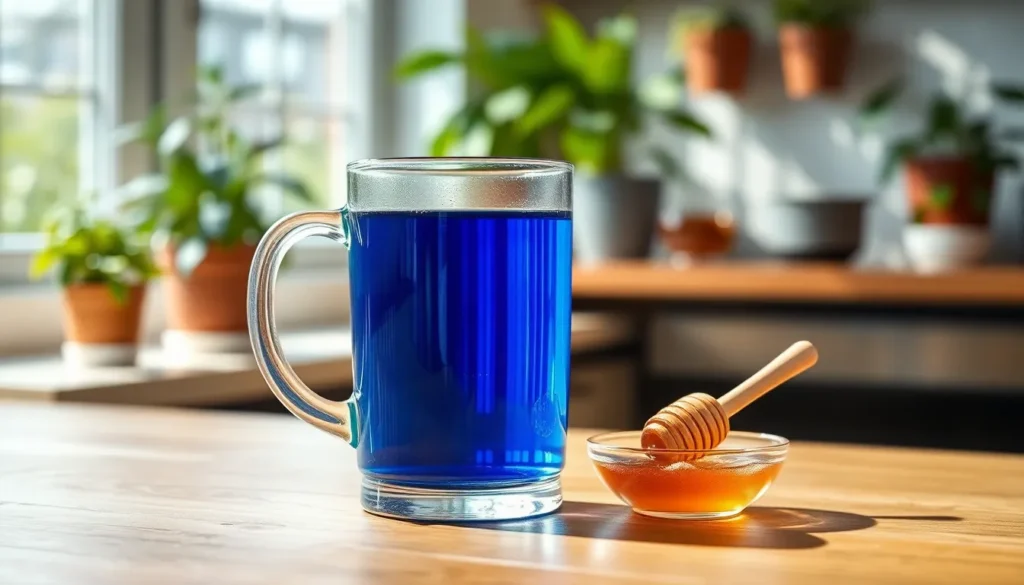We’ve discovered one of Mexico’s most treasured herbal remedies that’s been quietly making waves in the wellness community. Palo azul tea comes from the beautiful blue-tinged bark of the Eysenhardtia polystachya tree, native to Mexico and the southwestern United States. This remarkable brew transforms from amber to stunning fluorescent blue when exposed to sunlight – a natural phenomenon that’s as mesmerizing as it is beneficial.
For centuries, traditional Mexican healers have relied on palo azul for its incredible detoxifying properties and kidney support benefits. We’re excited to share this ancient wisdom with you through our simple yet authentic brewing method that captures all the therapeutic compounds this magical bark has to offer.
The best part? You don’t need any special equipment or complicated techniques. With just dried palo azul bark and water, we’ll guide you through creating this beautiful, health-boosting tea that tastes as good as it looks and delivers powerful wellness benefits with every sip.
What Is Palo Azul Tea
Palo azul tea comes from the dried bark of the Eysenhardtia polystachya tree. This remarkable tree grows naturally throughout Mexico and parts of the southwestern United States. We know this herbal beverage by several names including kidneywood tea and blue stick tea.
The bark creates a distinctive brewing experience that sets it apart from other herbal teas. When we first steep the dried bark pieces in hot water the liquid appears as a golden amber color. Sunlight exposure transforms this ordinary looking tea into something extraordinary. The fluorescent compounds in the bark react with UV light causing the tea to glow with an intense blue color.
Traditional Mexican healers have used palo azul for centuries as a natural remedy. They primarily relied on this bark tea for kidney cleansing and urinary tract support. The indigenous communities of Mexico passed down knowledge about its detoxifying properties through generations.
Modern herbalists continue to value palo azul for its potential health benefits. We find that many people seek out this tea specifically for kidney support and natural detoxification. The bark contains flavonoids and other bioactive compounds that contribute to its therapeutic reputation.
Preparation of palo azul tea requires only two simple ingredients. We need dried palo azul bark pieces and clean water to create this traditional beverage. The brewing process takes patience but demands no special equipment or complicated techniques.
Health Benefits of Palo Azul Tea
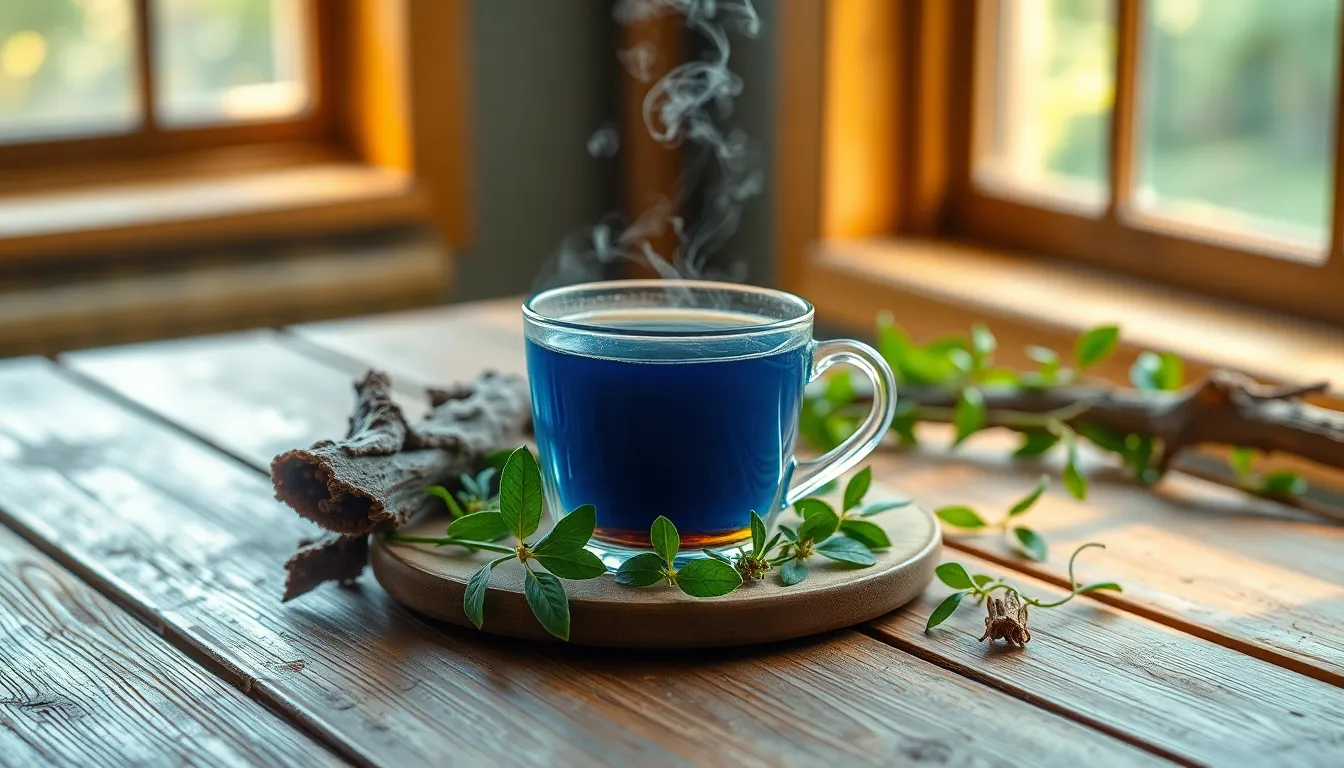
Traditional Mexican healers have recognized palo azul’s therapeutic properties for centuries, passing down knowledge of its remarkable effects on the body’s natural detoxification processes. We find that this ancient wisdom aligns with what modern herbalists continue to discover about the bark’s bioactive compounds.
Antioxidant Properties form the foundation of palo azul’s health benefits. The bark contains powerful antioxidants that help protect our cells from oxidative stress and free radical damage. These compounds work to neutralize harmful molecules in our system, supporting overall cellular health.
Digestive Health receives important support from regular palo azul consumption. Many users report improved digestive function and reduced gastrointestinal discomfort after incorporating this tea into their daily routine. The bark’s natural compounds help soothe the digestive tract and promote healthy gut function.
Inflammation Reduction represents another key benefit that sets palo azul apart from other herbal teas. Users frequently experience decreased inflammation throughout their body, which can contribute to improved joint comfort and overall wellbeing. The anti-inflammatory properties work systemically to address various inflammatory responses.
Detoxification remains the most celebrated benefit of palo azul tea, particularly for kidney and urinary tract support. The bark’s unique combination of flavonoids and bioactive compounds helps our kidneys filter toxins more effectively. Traditional uses focused specifically on kidney cleansing, and modern herbalists continue to value these detoxifying effects.
| Health Benefit | Traditional Use | Modern Application |
|---|---|---|
| Antioxidant Support | Cell protection | Free radical defense |
| Digestive Health | Stomach comfort | Gut function improvement |
| Inflammation Reduction | Pain relief | Systemic anti-inflammatory |
| Detoxification | Kidney cleansing | Urinary tract support |
We recommend consulting with a healthcare professional before using palo azul tea for medicinal purposes, especially if you have existing health conditions or take medications. The traditional benefits documented over generations provide a strong foundation, but individual responses may vary based on personal health factors.
Ingredients
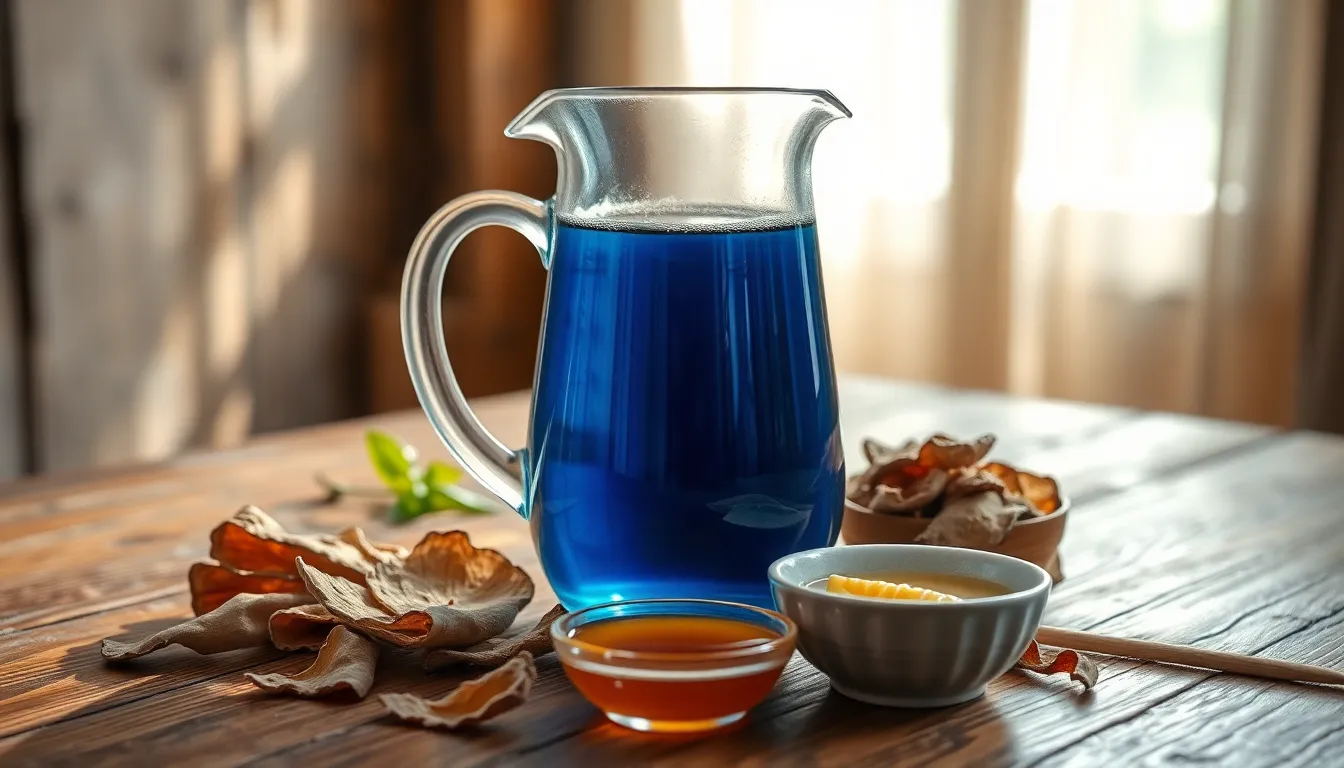
We keep the ingredient list simple for authentic palo azul tea brewing. Our recipe requires only a few basic components that work together to create this traditional herbal remedy.
Essential Ingredients:
- 2 tablespoons dried palo azul bark (for 8 cups of water)
- 8 cups filtered water
- Honey or sugar (optional, for sweetening)
Palo Azul Bark Selection:
We recommend using high-quality dried inner bark from the Eysenhardtia polystachya tree. The bark should appear clean and free from debris. For smaller batches, we use approximately 1/6 ounce of bark per 500 ml of water to maintain proper concentration.
Water Quality Matters:
Filtered or spring water produces the best results for our palo azul tea. Tap water with high mineral content can interfere with the bark’s natural compounds and affect the tea’s distinctive color change properties.
Optional Sweeteners:
Natural honey complements the earthy flavor profile while maintaining the tea’s traditional character. Raw sugar serves as an alternative sweetener. We add these after brewing to preserve the bark’s beneficial compounds during the steeping process.
| Batch Size | Palo Azul Bark | Water | Steeping Time |
|---|---|---|---|
| Small (2 cups) | 1/6 ounce | 500 ml | 20-30 minutes |
| Standard (8 cups) | 2 tablespoons | 8 cups | 20-30 minutes |
The beauty of palo azul tea lies in its simplicity. These basic ingredients transform into a remarkable beverage that showcases the bark’s natural fluorescent properties when exposed to sunlight.
Equipment Needed

Brewing authentic palo azul tea requires minimal equipment that most home kitchens already have on hand. We recommend gathering these essential items before starting your brewing process to ensure smooth preparation.
Basic Cooking Equipment:
- Stove or reliable heat source for consistent temperature control
- Medium to large pot with a tight-fitting lid (recommended for heat retention and preventing evaporation)
- Measuring tools for accurate bark and water portions
Straining and Serving Tools:
- Fine-mesh strainer or cheesecloth for removing bark particles
- Heat-resistant serving vessel or teapot
- Measuring cups for precise water measurement
The beauty of making palo azul tea lies in its simplicity. We find that using a pot with a lid significantly improves the brewing process by maintaining consistent heat and preventing water loss during the extended simmering time. A fine-mesh strainer proves essential for achieving the clean, clear tea that showcases palo azul’s distinctive color transformation properties.
Most standard kitchen equipment works perfectly for this traditional preparation method. We emphasize that specialized brewing equipment isn’t necessary, making this ancient remedy accessible to anyone interested in exploring its potential health benefits.
Instructions
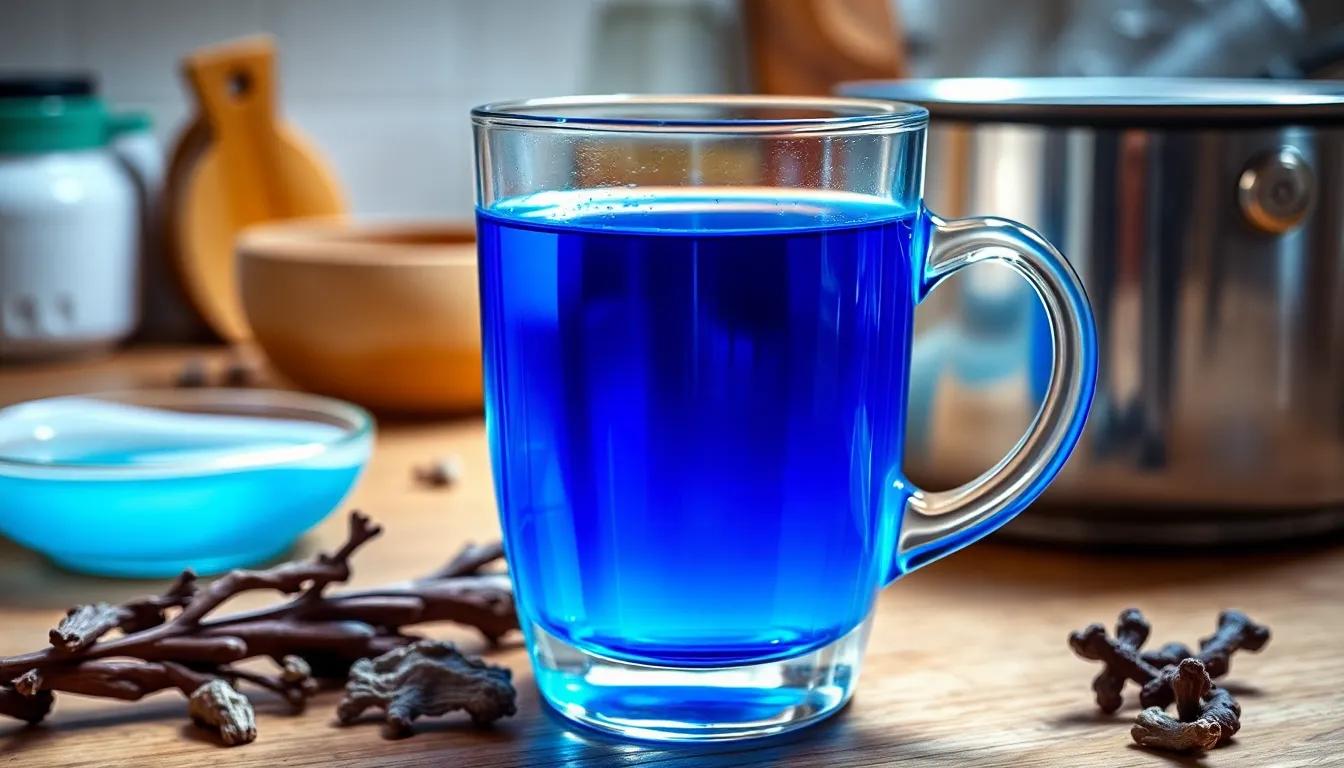
We’ll guide you through the simple process of brewing authentic palo azul tea that transforms from golden amber to stunning fluorescent blue. Follow these straightforward steps to create your own traditional herbal remedy.
Prep the Palo Azul Bark
We start by measuring 2 tablespoons of dried palo azul bark for every 8 cups of water. This ratio produces a well-balanced tea with optimal flavor extraction and beneficial compounds.
For stronger concentration, we can use 1 ounce (28 grams) of bark per gallon of water. Using more bark or reducing the water amount will create a more potent brew with enhanced therapeutic properties.
| Bark Amount | Water Volume | Tea Strength |
|---|---|---|
| 2 tablespoons | 8 cups | Standard |
| 1 ounce (28g) | 1 gallon | Concentrated |
| 3 tablespoons | 8 cups | Strong |
Boil the Water
We pour our filtered or spring water into a medium to large pot and bring it to a rolling boil. Alkaline or spring water works best because palo azul tea only develops its characteristic blue hue in alkaline conditions.
Filtered or tap water often contains acidic properties that prevent the stunning fluorescent transformation. We avoid using acidic water to ensure we achieve the tea’s signature visual appeal.
Steep the Tea
We add the measured palo azul bark directly to the boiling water once it reaches a rolling boil. The bark should maintain a strong boil for approximately 2 minutes to begin the extraction process.
After the initial boiling phase, we reduce the heat and allow the mixture to simmer for 20 to 30 minutes. This extended simmering time fully extracts the flavors and beneficial compounds from the bark.
Alternatively, we can boil the bark for 2 minutes, remove the pot from heat, and let it steep for 10 to 20 minutes for a standard infusion method.
Strain and Serve
We strain the finished tea using a fine-mesh strainer, tea infuser, or cheesecloth to remove all bark particles. Complete removal of bark ensures a smooth drinking experience.
The tea can be served immediately while hot or allowed to cool for a refreshing cold beverage. We add honey or sugar to taste if desired, though the tea has a naturally mild flavor.
For the most dramatic visual effect, we pour the strained tea into a clear glass and place it in direct sunlight where its blue fluorescence becomes clearly visible. Any leftover tea should be stored in the refrigerator to maintain freshness and preserve its antioxidant content.
Brewing Tips for Perfect Palo Azul Tea

The secret to brewing exceptional palo azul tea lies in mastering the fundamentals of water temperature and steeping time. We’ve discovered that small adjustments in these key variables can dramatically enhance both the tea’s therapeutic properties and its stunning visual transformation.
Water Temperature Guidelines
Water temperature plays a crucial role in extracting the bark’s beneficial compounds and achieving that signature blue fluorescence. We always start by bringing our water to a full rolling boil at 212°F (100°C) before adding the palo azul bark. This initial high temperature ensures maximum extraction of the flavonoids and bioactive compounds that make this tea so special.
Alkaline water enhances the blue color transformation that occurs when the tea is exposed to sunlight. We recommend using filtered or spring water with a pH between 7.5 and 8.5 for optimal results. The alkaline conditions help activate the fluorescent compounds in the bark that create the tea’s distinctive blue glow.
Maintaining the proper temperature throughout brewing ensures consistent extraction. We keep the water at a gentle boil when adding the bark then reduce to a steady simmer to prevent over-extraction of tannins that could create bitterness.
Steeping Time Recommendations
Timing determines both the strength and therapeutic potency of your palo azul tea. We recommend two primary brewing methods based on your flavor preferences and desired concentration.
| Brewing Method | Time | Result |
|---|---|---|
| Traditional Simmer | 20-30 minutes | Strong, concentrated flavor |
| Quick Boil & Steep | 2 minutes boil + 10-20 minutes steep | Milder, more delicate taste |
| Light Brew | 15 minutes simmer | Gentle introduction for beginners |
For maximum therapeutic benefits we suggest the traditional simmering method for 20 to 30 minutes. This extended brewing time allows complete extraction of the bark’s healing compounds while developing the tea’s full flavor profile. The longer steeping period also enhances the blue color intensity when exposed to natural light.
Those new to palo azul tea should start with the quick boil and steep method. We boil the bark for exactly 2 minutes then remove from heat and steep for 10 to 20 minutes depending on desired strength. This gentler approach produces a smoother taste while still providing substantial health benefits.
Monitor your tea’s color development during steeping as a guide for potency. We notice that deeper amber tones typically indicate stronger concentration of active compounds. The tea should maintain its golden amber appearance indoors and transform to brilliant blue when moved into direct sunlight.
Serving Suggestions

We recommend serving palo azul tea in clear glassware to showcase its remarkable color transformation. The tea’s golden amber hue shifts to a stunning fluorescent blue when exposed to natural sunlight, creating an impressive visual experience that enhances the drinking ritual.
Temperature Options
Both hot and cold preparations offer unique benefits for different occasions. Hot palo azul tea provides a soothing warmth that complements its earthy flavor profile, making it perfect for morning rituals or evening relaxation. Cold preparations deliver a refreshing experience that highlights the tea’s subtle sweetness, ideal for warm weather or post-workout hydration.
Glassware Selection
Clear glass containers maximize the visual impact of palo azul’s natural fluorescence. We suggest using transparent mugs for hot servings or tall glasses for cold preparations. The transparency allows you to observe the tea’s color changes while enjoying its therapeutic benefits.
Sweetening Recommendations
Traditional preparation requires no additives, allowing the bark’s natural properties to shine through. But, raw honey complements the tea’s earthy notes without overwhelming its delicate flavor. Light agave syrup provides another natural sweetening option that pairs well with the tea’s botanical character.
Optimal Serving Times
Morning consumption supports the body’s natural detoxification processes throughout the day. Evening servings promote relaxation and help prepare the body for restorative sleep. We recommend spacing servings throughout the day rather than consuming large quantities at once for maximum therapeutic benefit.
Portion Guidelines
| Serving Size | Frequency | Daily Maximum |
|---|---|---|
| 8 oz cup | 2-3 times daily | 24 oz |
| 12 oz glass | 2 times daily | 24 oz |
| 16 oz bottle | 1-2 times daily | 32 oz |
Sunlight Exposure
Position your glass near a window or outdoors to activate the tea’s signature blue fluorescence. Direct sunlight intensifies the color transformation, creating an almost magical drinking experience that connects you to this ancient remedy’s natural properties.
Storage Instructions
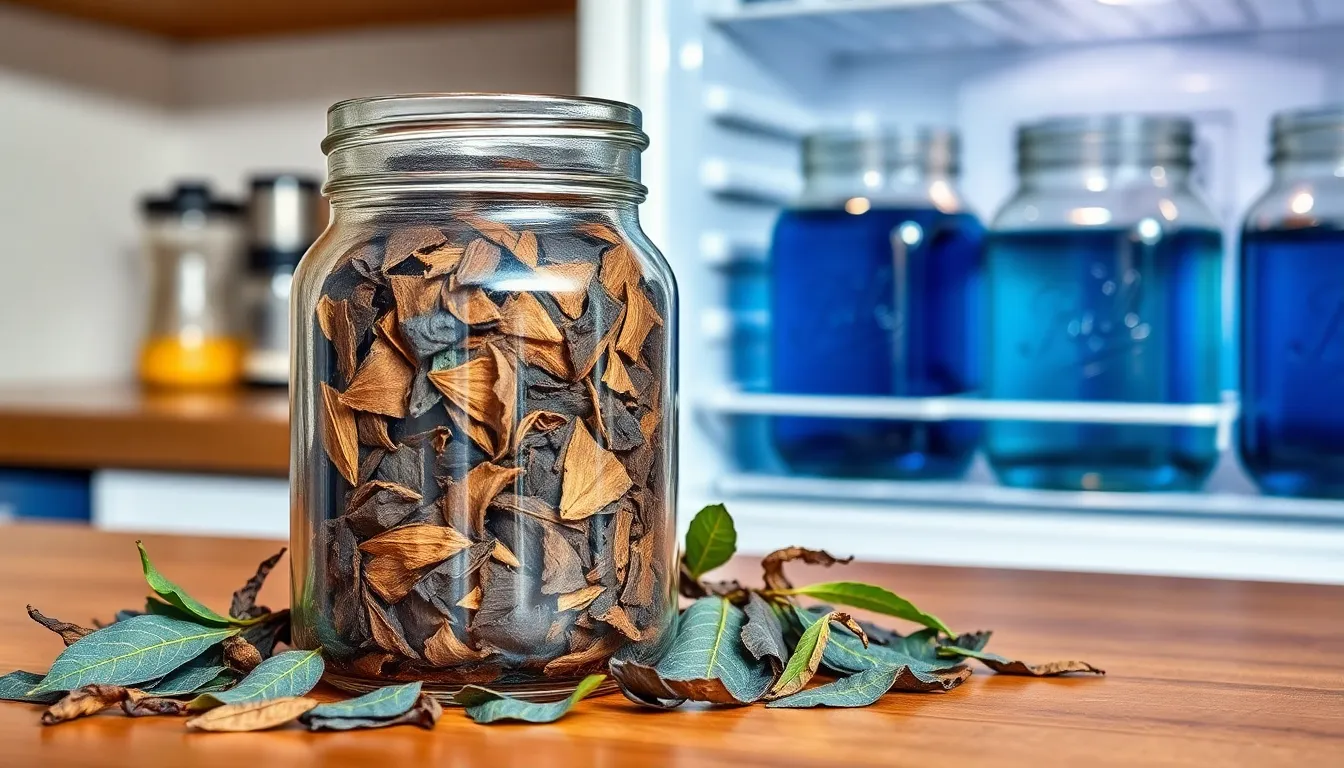
Proper storage ensures your palo azul tea maintains its potency and distinctive properties. We’ll guide you through the best practices for preserving both the dried bark and your freshly brewed tea.
Storing Dried Palo Azul Bark
We recommend storing dried palo azul bark in airtight containers to maintain optimal freshness and preserve the fluorescent compounds responsible for the tea’s color transformation. Glass jars with tight-fitting lids or vacuum-sealed bags work exceptionally well for long-term storage.
Keep your dried bark away from direct sunlight and moisture to prevent degradation of its active compounds. Store containers in a cool, dry pantry or cupboard where temperatures remain consistent. Under these conditions, properly stored palo azul bark retains its therapeutic properties for up to two years.
Check your stored bark periodically for any signs of moisture or mold. Fresh palo azul bark should maintain its natural woody aroma and light color when stored correctly.
Storing Brewed Tea
Store your brewed palo azul tea in the refrigerator to maintain its antioxidant properties and prevent spoilage. Glass containers or mason jars provide the best storage option as they don’t absorb flavors or odors like plastic containers might.
We suggest consuming your brewed tea within a few days for optimal flavor and maximum health benefits. The tea’s beneficial compounds remain most potent during this timeframe, ensuring you receive the full therapeutic value from each serving.
Label your stored tea with the brewing date to track freshness easily. Cold brewed palo azul tea actually intensifies in color over time, making refrigerated storage an excellent way to enhance the visual appeal of your next serving.
Variations and Flavor Additions

While traditional palo azul tea delivers exceptional health benefits on its own, we can easily customize this ancient remedy to suit different taste preferences. The bark’s naturally mild and slightly earthy flavor provides an excellent foundation for various enhancements that complement rather than mask its therapeutic properties.
Fresh herbs create the most popular flavor variations for palo azul tea. We recommend adding mint or spearmint leaves during the final 5 minutes of brewing to infuse a refreshing herbal aroma that enhances the tea’s cooling properties. These herbs pair beautifully with palo azul’s natural characteristics while adding their own digestive benefits.
Warming spices transform palo azul tea into a comforting beverage perfect for cooler weather. Cinnamon sticks added during the simmering process provide a sweet and warming note along with additional anti-inflammatory benefits. Fresh ginger slices offer a gentle spicy kick that complements the tea’s detoxifying properties while supporting digestive health.
Natural sweeteners help balance palo azul’s earthy undertones without interfering with its therapeutic compounds. Raw honey dissolves easily in both hot and cold preparations while adding antimicrobial properties. Pure sugar provides simple sweetening for those who prefer a more neutral flavor profile. We suggest starting with small amounts and adjusting to taste.
Vanilla extract creates an unexpectedly delightful variation that adds smooth aromatic sweetness to each cup. Just a few drops transform the tea into a sophisticated beverage that appeals to those who typically avoid herbal teas.
Citrus additions brighten palo azul tea’s flavor profile significantly. Fresh lemon juice creates a refreshing twist that makes the tea more appealing during warmer months. The citrus acids also help preserve the tea’s antioxidant content while adding vitamin C benefits.
| Flavor Addition | Amount per 8 cups | Brewing Method | Flavor Profile |
|---|---|---|---|
| Fresh mint | 6-8 leaves | Add last 5 minutes | Refreshing, cooling |
| Cinnamon stick | 1 stick | Add during simmering | Warm, sweet, spicy |
| Fresh ginger | 3-4 slices | Add during simmering | Warming, digestive |
| Raw honey | 2-3 tablespoons | Stir into finished tea | Sweet, antimicrobial |
| Vanilla extract | 1/2 teaspoon | Add to finished tea | Smooth, aromatic |
| Lemon juice | 2-3 tablespoons | Add to finished tea | Bright, citrusy |
These variations allow us to customize palo azul tea while maintaining its traditional health promoting properties. Each addition brings unique benefits that work synergistically with the bark’s natural compounds to create a more enjoyable and potentially more therapeutic beverage experience.
Make-Ahead Instructions
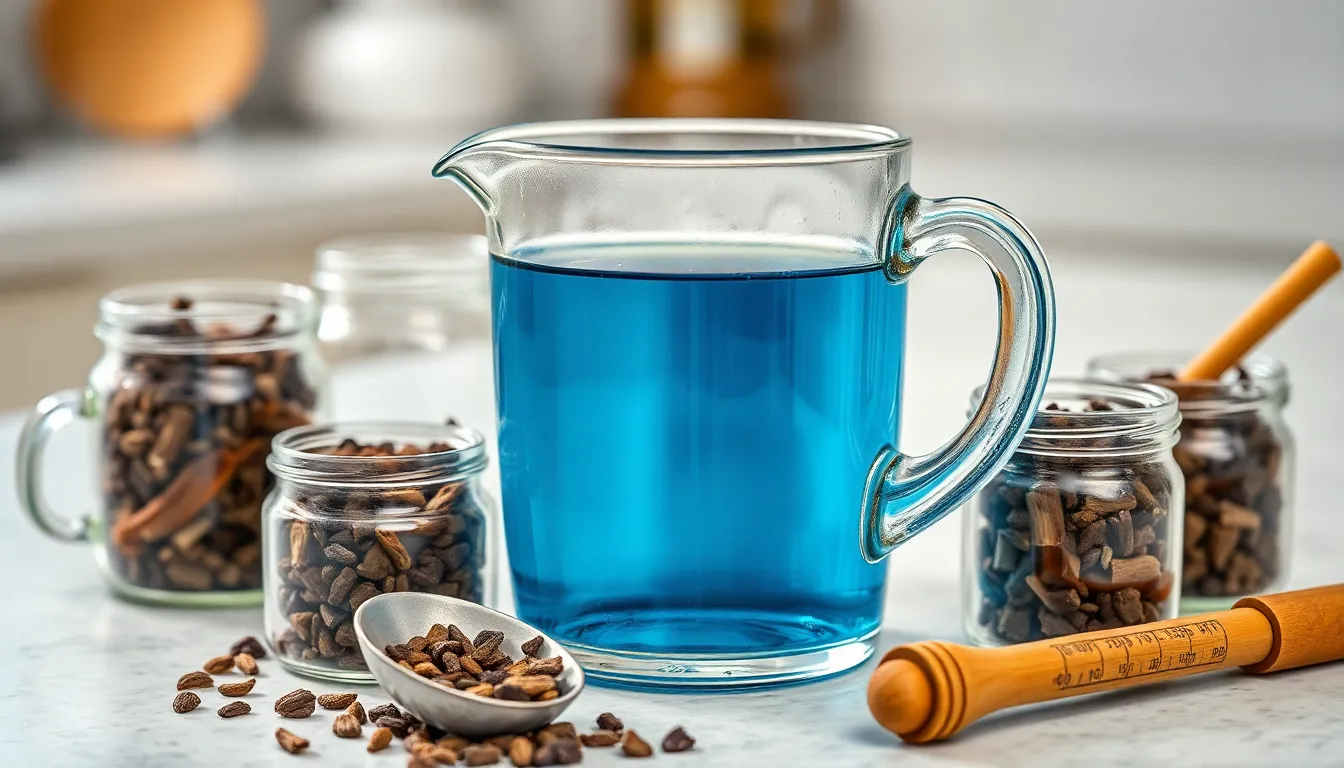
Preparing palo azul tea in advance allows us to enjoy this beneficial beverage throughout the week while maximizing our time and maintaining optimal flavor. We recommend brewing larger batches during weekend meal prep sessions to ensure fresh tea remains available for daily consumption.
Batch Brewing Schedule
We suggest preparing palo azul tea every 3-4 days to maintain peak freshness and therapeutic potency. Start by multiplying our basic recipe proportionally for larger quantities. For weekly preparation we can use 6 tablespoons of dried palo azul bark with 24 cups of filtered water to create enough tea for several days.
Advanced Preparation Steps
Begin the make-ahead process by measuring and storing pre-portioned bark quantities in small containers or pouches. This preparation method saves time during busy weekdays and ensures consistent brewing ratios. We can portion individual serving amounts using 1 tablespoon of bark per 4 cups of water for single-batch preparations.
Proper Storage Techniques
Freshly brewed palo azul tea maintains its antioxidant properties and distinctive blue fluorescence when stored correctly in glass containers. We recommend dividing large batches into smaller glass jars or bottles immediately after straining and cooling. This portioning method prevents frequent opening of one large container which can compromise the tea’s beneficial compounds.
Temperature Management
Allow freshly brewed tea to reach room temperature before refrigeration to prevent condensation buildup inside storage containers. We can speed this cooling process by placing the pot in an ice bath while stirring occasionally. Once cooled the tea should be transferred to refrigerator storage within 2 hours of brewing.
Extended Storage Options
For longer storage periods we can freeze portions of brewed palo azul tea in ice cube trays for convenient single-serving additions to water bottles. These frozen cubes retain therapeutic properties for up to 3 months and provide instant access to concentrated palo azul benefits. We recommend using silicone ice cube trays to prevent freezer burn and ensure easy removal.
Reheating Guidelines
Previously brewed tea can be gently reheated on the stovetop over low heat to preserve delicate compounds that provide health benefits. We avoid using microwave heating as it can create hot spots that may damage beneficial plant compounds. For cold preparations simply pour chilled tea over ice and enjoy the refreshing blue-tinted beverage without additional heating.
Conclusion
We’ve shared everything you need to know about brewing authentic palo azul tea at home. This remarkable herbal remedy offers a simple yet powerful way to support your wellness journey with its traditional detoxifying properties and stunning visual transformation.
The beauty of palo azul lies in its simplicity – just bark and water create a therapeutic beverage that’s been trusted for generations. Whether you prefer it hot for comfort or cold for refreshment the brewing process remains straightforward and accessible to everyone.
Remember to source quality dried bark and use filtered water for the best results. With proper storage and these proven techniques you’ll have a reliable supply of this ancient remedy ready whenever you need it.
Start with our basic recipe and experiment with natural flavor additions to create your perfect cup. Your journey with palo azul tea begins with that first magical sip.
Frequently Asked Questions
What is palo azul tea?
Palo azul tea is a herbal remedy made from the blue-tinged bark of the Eysenhardtia polystachya tree, native to Mexico and the southwestern U.S. Also known as kidneywood tea or blue stick tea, it’s famous for its unique color transformation from golden amber to fluorescent blue when exposed to sunlight, thanks to natural fluorescent compounds in the bark.
What are the main health benefits of palo azul tea?
Palo azul tea offers several health benefits including powerful antioxidant properties that protect cells from free radical damage, improved digestive health, anti-inflammatory effects for joint comfort, and most notably, detoxification properties that support kidney cleansing and urinary tract health through its flavonoids and bioactive compounds.
How do you brew palo azul tea?
To brew palo azul tea, use 2 tablespoons of dried palo azul bark per 8 cups of filtered water. Boil the water, add the bark, and simmer for 20-30 minutes for maximum benefits. Strain the tea and serve hot or cold. The simple process requires no special equipment or complicated techniques.
Why does palo azul tea change color?
The tea changes color due to natural fluorescent compounds in the bark. When brewed, it appears golden amber, but when exposed to sunlight or UV light, it transforms into a brilliant fluorescent blue. This unique characteristic is one of the tea’s most distinctive features and requires alkaline water conditions to occur.
How should I store palo azul tea and bark?
Store dried palo azul bark in airtight containers away from direct sunlight and moisture in a cool, dry pantry where it retains potency for up to two years. Brewed tea should be stored in glass containers in the refrigerator and consumed within a few days for optimal freshness and therapeutic benefits.
Can I add flavors to palo azul tea?
Yes, you can enhance palo azul tea with various additions including fresh herbs like mint, warming spices such as cinnamon or ginger, natural sweeteners like raw honey, vanilla extract, or citrus juice. These additions complement the tea’s mild flavor while contributing additional health benefits without compromising its traditional therapeutic properties.
What type of water should I use for brewing?
Use filtered or spring water with a pH between 7.5 and 8.5 for optimal results. Alkaline water conditions are essential for extracting the tea’s beneficial compounds and achieving the characteristic blue color transformation. Avoid distilled or highly acidic water as it may prevent proper extraction of active compounds.
How often should I drink palo azul tea?
Space servings throughout the day for maximum therapeutic benefits. The article suggests making larger batches every 3-4 days to maintain freshness. However, it’s important to consult with a healthcare professional before using palo azul tea for medicinal purposes, especially if you have existing health conditions or take medications.

